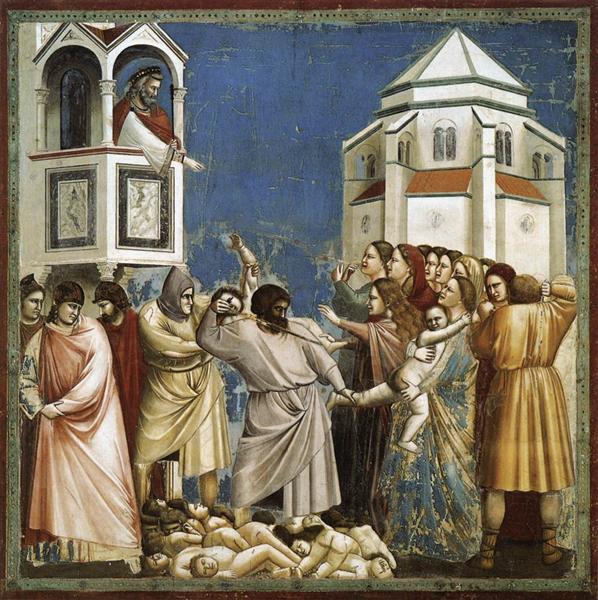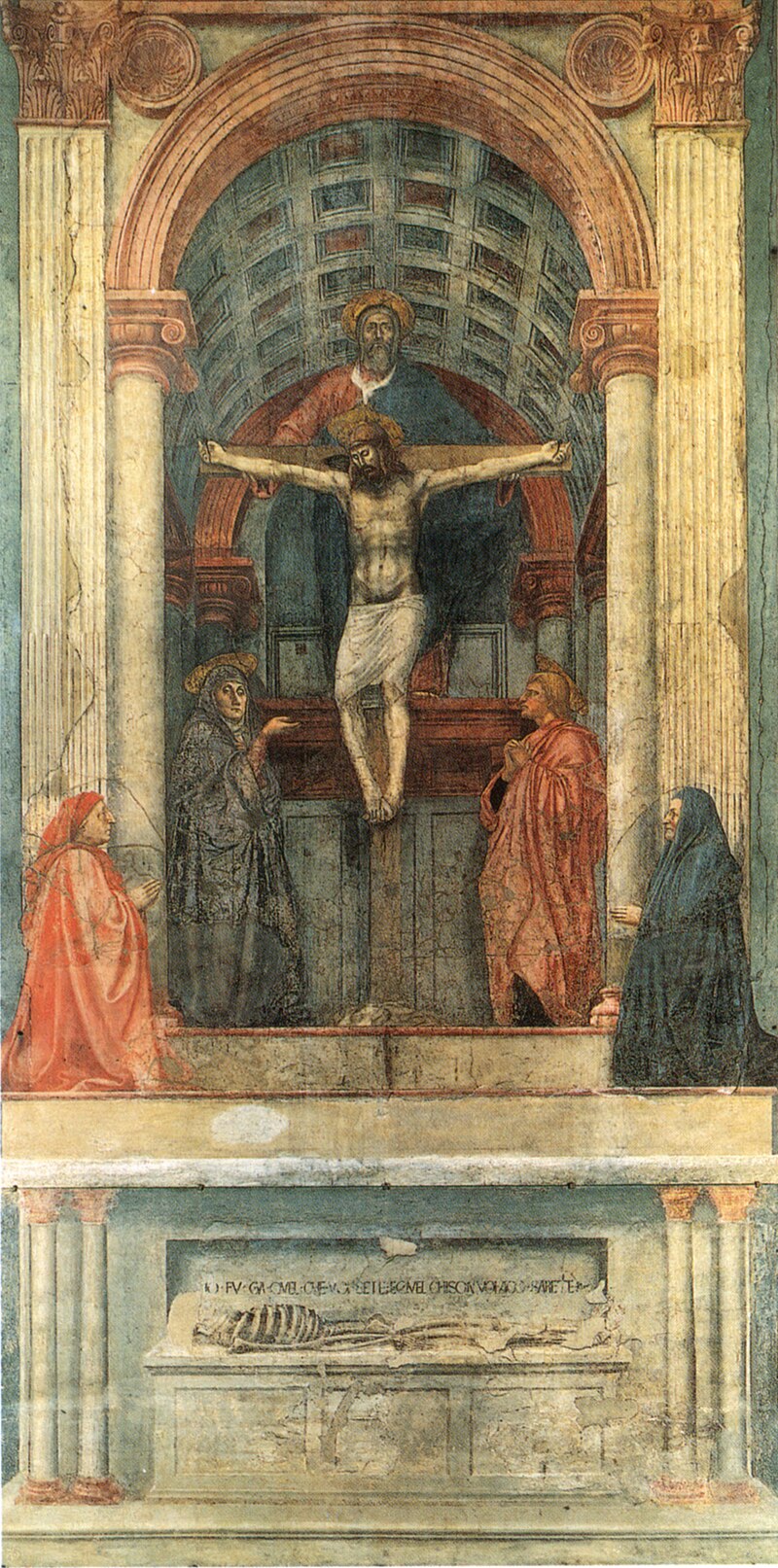Early Renaissance in Italy (Unit 1: Lectures 1 & 2)
1/172
There's no tags or description
Looks like no tags are added yet.
Name | Mastery | Learn | Test | Matching | Spaced |
|---|
No study sessions yet.
173 Terms
Renaissance
Literally means 'rebirth' of classical knowledge. Cultural rebirth inspired by classical antiquity. Cultural revival beginning in Italy. The term used by the people at the time to classify the time period - impressive that it has lasted to today.
Classicism
Hybrid culture of Ancient Greek and Roman traditions with no clear distinction between the two. The Renaissance sought to revive these ideals, believing them to have been “forgotten” in the “Dark Ages.”
Dark Ages
Period before Renaissance, viewed as ignorance to Greek/Roman culture by Renaissance thinkers.
Calamitous 14th Century
Term for upheaval leading to the Renaissance. Included the Great Famine, Black Plague, and the Hundred Years War.
Great Famine
1 in 4 harvests failed, devastating a pre-industrialization society and causing millions of deaths.
Black Death
Plague that killed ~25 million Europeans, 30-60% of the population.
100 Years' War
Conflict between England and France, millions of civilian casualties.
Italian Scholars
Invented the term 'Renaissance' in the 1300s.
Modern Archaeology
Tools developed post-Renaissance to analyze ancient art.
Social Upheaval
Renaissance emerged from crises of the 14th century.
Civilian Casualties
Most deaths in 100 Years' War were non-combatants.
Guerrilla Warfare
Unorganized fighting during the 100 Years' War.
Candle of Knowledge
Metaphor for rediscovery of classical learning.
Historical Distinction
Modern assessments differentiate Greek and Roman art.
Cultural Legacy
Renaissance influenced subsequent art and intellectual movements.
Feudalism
The social/economic structure of the medieval period featuring a king/emperor at the top and peasants/serfs at the bottom. Made a hard distinction between nobles and everyone else. Collapsed due to the events of the Calamitous 14th Century, resulting in a more diversified economy.
Peasants
Lowest social class in feudal society.
Merchant Class
Emerging economic group between nobles and peasants.
Religious Authority
Clergies are considered justice and have more power than royalty. Questioned upon the arrival of the Black Death, where many wondered what they were getting in return for their loyalty after being promised protection.
Clergy
Religious leaders considered powerful in medieval society.
Italy
Birthplace of the Renaissance, rich in classical heritage.
City-States
Independent regions in Italy during the Renaissance having newly acquired freedom from the Holy Roman Empire.
Humanism
The study of what humans create. Not necessarily at odds with religion and worked with it during the Renaissance. Studying what humans created was believed to be the best way of understanding God’s intentions, as humans are God’s greatest creations.
Medieval Philosophy
Theological inquiries about God's intentions.
Individual Vision
Emphasis on personal creativity in Renaissance art.
Artistic Signatures
Artists began signing their works in the Renaissance.
Economic Growth
Rise of trade and wealth in Renaissance Italy.
Classical World
Ancient Greek and Roman civilization influencing the Renaissance.
Political Fragmentation
Lack of unified Italy during the Renaissance.
Theological Nature
Medieval philosophy focused on divine questions.
Renaissance Artists
Became known and celebrated for their work.
History Painting
Art depicting historical, mythological, or biblical subjects. Became a way of expressing the humanist devotion to the products of man’s creativity and showcasing one’s understanding and appreciation of the past.
Erasmus Quote
"Good education is better than good birth."
Nobility
Became a trait that anyone could possess with the rise of humanism and the collapse of feudalism rather than a status given by birth as it was seen in the medieval period.
Church and wealthy middle class
Who purchased art during the Renaissance.
Naturalism
Adopted in Renaissance art due to the Greeks’ focus on it.
Cimabue
Proto-Renaissance artist bridging medieval and Renaissance styles. Very much inspired by Byzantine art.
Byzantine Art Influence
Byzantine artists preserved classical naturalism during medieval times.
Iconoclasm
Destruction of icons and persecution of icon artists in the Byzantine Empire who fled to Italy. The migration later impacted the art of Italy during the Renaissance.
Italo Byzantine Style
Italian adaptation of Byzantine art techniques.
Foreshortening
Technique to create depth in art.
Giotto
Pre-Renaissance artist known for innovative frescoes. Made a name for himself producing Madonna and Child tempera on paintings but was later commissioned for frescoes on the interior of chapels. Credited to significant innovations.
Madonna and Child
Popular subject in Renaissance art, often painted.
Arena Chapel
Location of Giotto's significant fresco series.

Massacre of the Innocents
Biblical story depicted in Giotto's fresco. King Herod orders the execution of all infant boys after being told that the King of Jews was born (referring to Jesus). Very dramatic and violent. Here, Giotto innovates by using a blue background and by telling a strong narrative within the work.
Proto-Renaissance
Transitional art period before the Renaissance. Also known as the Italo Byzantine style. Refers to Italian artists making Byzantine-style art.
Transitional Artist
Artist bridging two distinct art periods.
Byzantine Naturalism
Classical realism maintained within Christian themes.
Renaissance Market
High demand for small, portable panel paintings.
Cimabue's Gold Background
Characteristic Byzantine style in Cimabue's works.
Artistic Legacy
Influence of earlier styles on Renaissance artists.
King Herod
Ruler who orders the massacre of infants.
Infanticide Decree
Herod's order to kill all infant boys.
Giotto’s Innovations
Incorporating a blue background to situate a scene in our real world, including a strong narrative with emotion, and creating depth through the use of background elements - the beginnings of perspective.
Byzantine Icons
Religious art with gold backgrounds, lacking narrative.

The Lamentation
Scene depicting mourning after Christ's crucifixion. By Giotto who created depth through the use of background elements. Shows Christ’s followers mourning his death after his body was taken off the cross. Blue background. Indicated that Giotto knew that not everyone responded to grief the same way. Emotional drama and narrative.
Perspective
Illusion of depth in art, beginning with Giotto. Developed heavily and immensely focused on during the Renaissance. Seen as essential to the making of good art. In the medieval era, depth was accomplished by stacking figures on top of each other - during the Renaissance, artists do not need to rely on this technique and can condense the number of figures they represent, because they don’t need figures to show depth.
Narrative Art
Art that tells a story through visual elements.
Emotional Drama
Variations in grief depicted by figures in art.
Grim Determination
Soldiers' expression showing discomfort with their orders in Massacre of the Innocents.
Mothers' Pleas
Emotional cries of mothers for their children's lives in Massacre of the Innocents.
Western Art Assumption
Art functions as a window to reality.
Abstract Art
Movement challenging traditional Western art assumptions.
Physical Reality
Giotto's grounding of scenes in the real world.
Visual Weight
Illusion of presence created by depth in figures.
Giorgio Vasari
Artist and author of 'The Lives of the Artists'.
The Lives of the Artists
Vasari's book detailing Renaissance artists' biographies. Generally flavored Florence.
Medici Family
Wealthy banking family influential in Renaissance art. A prime example of Renaissance artistic patronage and the new middle class. Collected taxes for the pope. Their immense wealth allowed them to buy their way into Florentine politics. Asserted their authority through a number of commissions.
Artistic Patronage
Support from wealthy patrons for artists' works. Exploded during the Renaissance with the rise of Humanism and a desire for more luxury goods as well as the arts arms race among Italian city-states (newly independent from the Holy Roman Empire).
Renaissance Middle Class
Wealthy non-nobles asserting influence through art.
Patron Requests
Specific demands made by patrons to artists.
Artistic Genius
Talented artists recognized for their innovative works.
Renaissance Art
Art characterized by humanism and classical themes. Placed emphasis on individual vision and creativity as artists begin signing their works.
Biographical Sketches
Brief profiles of significant Renaissance artists.
Art Dimensions
Specific measurements requested by patrons for artworks.
Subject Matter
Themes or topics specified by patrons for art.
Composition of Figures
Arrangement of subjects in a work of art.
Color and Background
Patrons' specifications for artwork's visual elements.
Innovations in Art
New techniques and styles developed during the Renaissance.
Renaissance Artists
Creators of art reflecting humanist ideals.
Historical Context
Understanding Renaissance art within its cultural framework.
Renaissance Art Philosophies
Cultural movement emphasizing humanism and classical learning.
Masaccio
Early Renaissance artist known for innovative techniques. The go-to reference point for later, more famous Renaissance artists. Solved a common problem for artists by including patrons in an area outside scenes with religious figures. Loved for his ability to perfectly render Roman architecture. Most notably used linear perspective in a shockingly sophisticated manner with the assistance of Bruneleski.

Holy Trinity
Masaccio's significant work featuring linear perspective. A testament to how talented Masaccio was in his ability to execute precise perspective using a quick-drying and unforgiving medium.
Linear Perspective
A new means of rendering the recession of space.
Orthogonals
Lines radiating from the vanishing point in perspective.
Fillippo Bruneleski
Architect credited with developing linear perspective principles. Friends with Masaccio; most likely recommended the concept to him leading to its incorporation in Masaccio’s Holy Trinity.
Mortality Message
Reminder of death's inevitability in Masaccio's work. A message near the skeleton at the bottom of the Holy Trinity reminding those there to keep following God.
Corinthian Columns
Architectural style used in Masaccio's Holy Trinity. Ornate column style referencing classical architecture.
Engaged Columns
Columns attached to a wall, enhancing architectural depth.
Barrel Vaulted Ceiling
Ceiling formed by extending a single curve along a space.
Rafael
Later Renaissance artist influenced by Masaccio's techniques.
Michelangelo
Famous artist who admired and emulated Masaccio.
Art as a Window
Concept linking art's realism to rational understanding. Analogy coined by Giotto and informed how he represented the world in his work.
Fresco
Technique of mural painting on freshly laid wet plaster.
Public Work
Art commissioned for communal viewing and appreciation.
Rationality and Logic
A goal of Renaissance art. If a work of art possesses these qualities, then, by extension, our world does, allowing people to learn about it in a straightforward way.
Artistic Commission
Formal request for an artwork, often by patrons.
Wet fresco
Technique using wet plaster for painting.
Buon fresco
Italian term for true fresco technique.